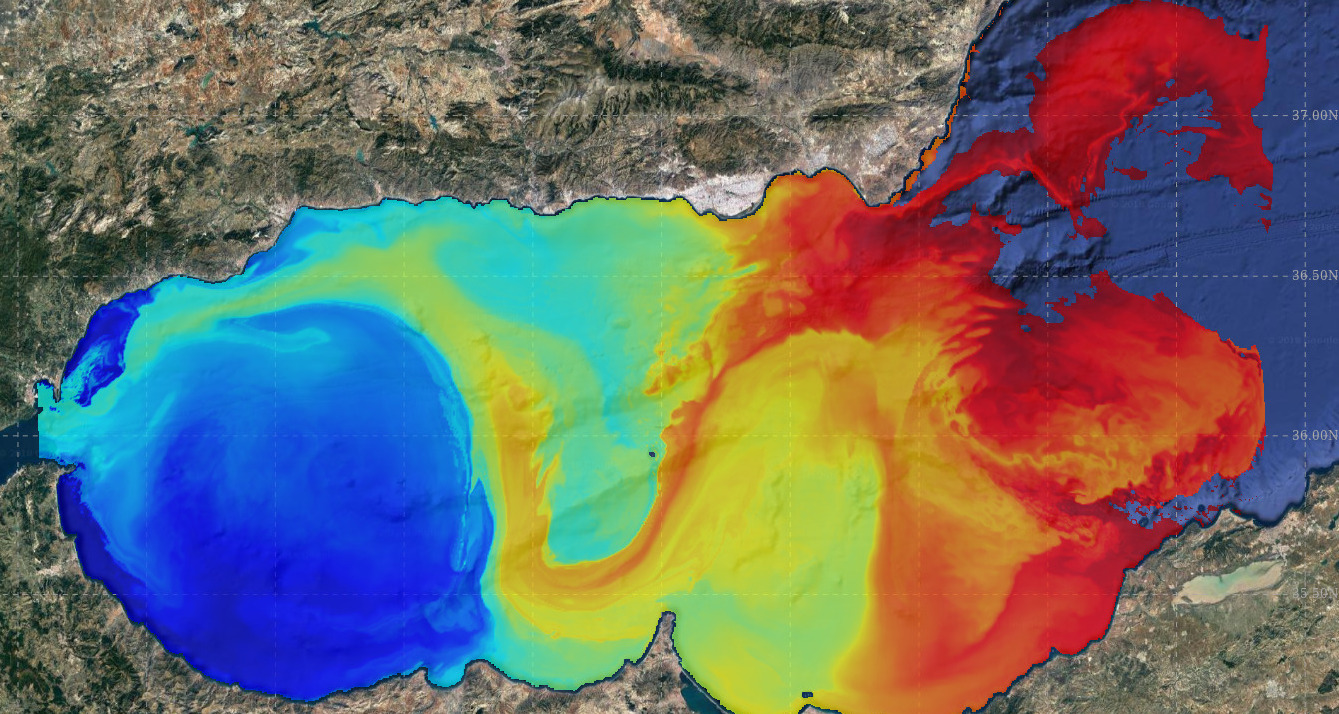Coherent Lagrangian Pathways from the Surface Ocean to Interior (CALYPSO):
Four-Dimensional Lagrangian Analysis, Numerics, and Estimation Systems (4D-LANES)
|
P.F.J. Lermusiaux, P.J. Haley Jr., C. Mirabito, M. Doshi, K. Gkirgkis, A. Gupta, C.S. Kulkarni Massachusetts Institute of Technology
|
Project Summary Ongoing MIT-MSEAS Research MSEAS CALYPSO-supported Publications Additional CALYPSO Links Background Information
|

|
|
| This research is sponsored by the Office of Naval Research. | |||
Project Summary
Describing and quantifying the truly three-dimensional and time-dependent transports of ocean properties from the surface ocean to the interior is a fascinating observational, theoretical, and modeling challenge. The "Coherent Lagrangian Pathways from the Surface Ocean to Interior (CALYPSO)" initiative addresses this challenge, with a focus on the southwest Mediterranean Sea region. Our MSEAS goal is to develop novel efficient four-dimensional Lagrangian analysis theory and methods, and apply and expand our capabilities in multi-resolution multi-disciplinary ocean modeling, uncertainty, predictability, and Lagrangian–Eulerian data assimilation, to predict and characterize multiscale ocean transports, coherent structures, and subduction/stirring/mixing processes, and optimally guide ocean platforms towards the most informative observations.
Background information is available below.
| Top of page |
Ongoing MIT-MSEAS Research
Long-Term (Collaborative) MIT-MSEAS Goal:
Develop novel efficient four-dimensional Lagrangian analysis theory and methods, and apply and expand our capabilities in multi-resolution multi-disciplinary ocean modeling, uncertainty, predictability, and Lagrangian–Eulerian data assimilation, to predict and characterize multiscale ocean transports, coherent structures, and subduction/stirring/mixing processes, and optimally guide ocean platforms towards the most informative observations.
Specific Objectives:
- Derive and utilize novel efficient four-dimensional Lagrangian transport theory and methods rooted in fundamental equations and high-order schemes to predict, analyze, and characterize multiscale ocean transports, coherent structures, and material sets
- Develop and apply new probabilistic Lagrangian predictions and Bayesian Eulerian–Lagrangian data assimilation using our stochastic DO equations and non-Gaussian filters and smoothers
- Apply and expand our multi-resolution submesoscale-to-regional-scale ocean modeling, 2-way nesting and tiling, and uncertainty and predictability predictions, for innovative physical, biological, and acoustical real-time forecasting and careful process and sensitivity studies
- Improve the understanding of ocean processes occurring in complex frontal regions, focusing on (sub)-mesoscale instabilities, subduction from the mixed layer, frontogenesis, and mixing, and the corresponding biogeochemical and acoustical effects
- Help design field experiments and predict sampling strategies during sea operations that maximize mutual information on 4D pathways, velocity, structures, and parameterizations
- Collaborate and transfer data, expertise, approaches, algorithms and software to NRL and other colleagues. Utilize and leverage the MIT Naval Officer education program
Real-Time Sea Exercises
We will be conducting real-time sea exercises in the Alboran Sea during March-April 2019. We provide varied data processed by our group, the MSEAS-PE ocean field forecasts (plus interactive maps), and Lagrangian transport and coherent structure analyses.
2019 Real-Time Sea Exercise page
We will be also be conducting real-time sea exercises in the Balearic Sea during February-March 2022. We provide varied data processed by our group, the MSEAS-PE ocean field forecasts (plus interactive maps), along with Lagrangian transport, coherent structure analyses, and subduction forecasts.
2022 Real-Time Balearic Sea Exercise page
Publications
MSEAS CALYPSO-supported Publications
Awards
| Top of page |
Additional CALYPSO Links
- WHOI CALYPSO Main Page
- Alboran Sea Bathymetric Features
- Calypso Modeling Projects
- Sub-Mesoscale Ocean Dynamics Experiment (S-MODE)
| Top of page |
Background Information
Our first motivation is to build upon and further develop a wealth of recent advances by our research group in efficient four-dimensional (time and space) Lagrangian theory and methods (Feppon and Lermusiaux, 2018a,c). Our approach is rooted in the fundamental Eulerian partial differential equations (PDEs) for the Lagrangian flow map. With our novel numerical method of composition, we can solve these PDEs accurately and efficiently (Kulkarni and Lermusiaux, 2018). As a result, we plan to provide quantitative 4D Lagrangian predictions, analyses, and characterizations of multiscale ocean transports, coherent structures, material sets, and subduction/stirring/mixing processes and regions.
A second motivation is to apply and expand our capabilities in multi-resolution submesoscale-to-regional-scale ocean modeling, 2-way nesting and tiling, and uncertainty and predictability predictions, to allow innovative studies of the dynamics in the DRI's southwest Mediterranean Sea region.
The third motivation is to collaborate with observational scientists to help design field campaigns and utilize rigorous optimal sampling strategies. The campaigns can be optimized to provide the most information on: dynamic 3D pathways; vertical and/or horizontal velocities; 4D coherent structures; and/or quantities most useful to learn accurate parametrizations. The main application region will be the very interesting southwest Mediterranean Sea and the complex dynamics of the Alboran Sea frontal structures.
Our 4D-LANES project is intended to be part of the overall integrated DRI effort involving national and international observing and modeling scientists. Our theoretical studies, quantitative modeling, dynamics analyses, and optimal sampling will be motivated by and coordinated with field campaigns and other efforts. Our results can inform sea operations at different stages: planning/design/execution of experiments; interpretation of the data; and development of high-level understanding. Real-time deterministic and probabilistic forecasting, including Lagrangian predictions, adaptive sampling guidance, and path planning forecasts, is included in the proposed research. We plan to provide such real-time forecasts and analyses during the relevant sea campaigns. To maximize the chances of success of the DRI, we also plan to organize exchanges and visits with partners, and to transfer our results, in agreement with the guidance we receive.
| Top of page |


